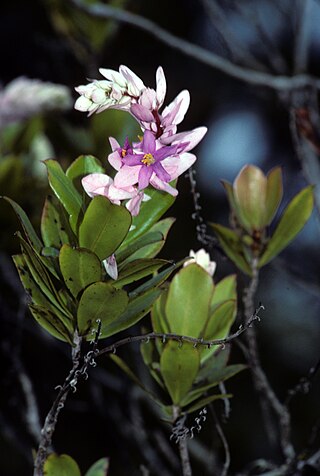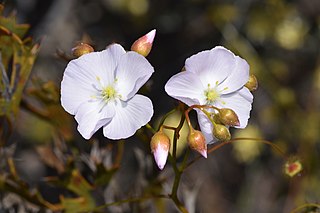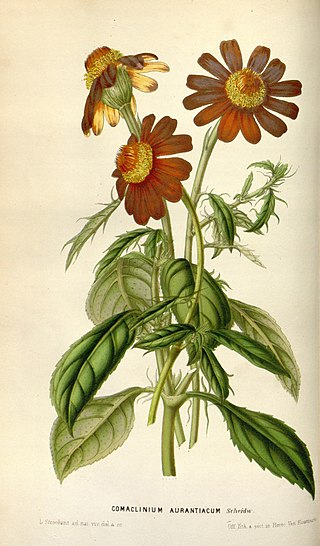
Egeria is a genus of three species of aquatic plants in the family Hydrocharitaceae described as a genus in 1849. native to warm-temperate South America.

Guillaume Rondelet, also known as Rondeletus/Rondeletius, was Regius professor of medicine at the University of Montpellier in southern France and Chancellor of the University between 1556 and his death in 1566. He achieved renown as an anatomist and a naturalist with a particular interest in botany and ichthyology. His major work was a lengthy treatise on marine animals, which took two years to write and became a standard reference work for about a century afterwards, but his lasting impact lay in his education of a roster of star pupils who became leading figures in the world of late-16th century science.

Purdiaea is a genus of flowering plants in the family Clethraceae described as a genus in 1846. It is one of two genera in this family, and was formerly classified in the related family Cyrillaceae. Purdiaea is native to tropical regions of the Caribbean, Central America and northern South America, further south than the related genus Clethra, the only other genus of this family.

Dendropanax is a genus of flowering plants in the family Araliaceae, consisting of 92 species of evergreen trees and shrubs, first described by Joseph Decaisne & Jules Émile Planchon in 1854. They are native to Central and South America, eastern Asia and the Malay Peninsula. Species such as Dendropanax trifidus or "kakuremino" in Japanese, are used in roji gardens, traditional moist and mossy areas leading to the chashitsu for tea ceremonies.

The Cochlospermaceae were a family of two genera and 20-25 species of trees and shrubs, first described by Jules Émile Planchon in 1847. They have been included in the Bixaceae from the APG III system onwards. The older APG II system treated this family as an optional segregate of Bixaceae. They occur widely throughout the tropical regions of the world, but are curiously absent from Malaysia. Most species in this family are mesophytic or xerophytic, growing primarily in drier climates.

Jules Émile Planchon was a French botanist born in Ganges, Hérault.
Cuphocarpus is an obsolete genus of flowering plants in the family Araliaceae. Mabberley (2008) treated it as a synonym of Polyscias, but other authors still recognized it at that time. In 2010, in a phylogenetic analysis of DNA sequences, it was shown that Cuphocarpus was biphyletic and embedded in the large genus Polyscias. In an accompanying paper, Polyscias was divided into 11 subgenera, with seven species left incertae sedis.

Arachnothryx is a genus of flowering plants in the family Rubiaceae. It contains about 107 species. It is found from Mexico to Peru and in Trinidad.

The Great French Wine Blight was a severe blight of the mid-19th century that destroyed many of the vineyards in France and laid waste to the wine industry. It was caused by an aphid that originated in North America and was carried across the Atlantic in the late 1850s. The actual genus of the aphid is still debated, although it is largely considered to have been a species of Daktulosphaira vitifoliae, commonly known as grape phylloxera. While France is considered to have been worst affected, the blight also did a great deal of damage to vineyards in other European countries.

Drosera drummondii is a plant in the family Droseraceae, native to Western Australia.

Ampelocissus latifolia is a plant in the Vitoideae subfamily of the grape family native to the Indian subcontinent.

Drosera glanduligera, commonly known as the pimpernel sundew or scarlet sundew, is a species of carnivorous plant endemic to southern Australia. It is an ephemeral annual plant that grows in the winter and flowers from August to November.
Ampelocissus barbata is a species of liana in the grape family Vitaceae. It was originally described from Sylhet by Nathaniel Wallich and placed in the genus Vitis. The species was moved to Ampelocissus by Jules Émile Planchon in 1884.

Urceolina amazonica, formerly known as Eucharis amazonica, is a species of flowering plant in the family Amaryllidaceae, native to Peru. It is cultivated as an ornamental in many countries and naturalized in Venezuela, Mexico, the West Indies, Ascension Island, Sri Lanka, Fiji, the Solomon Islands and the Society Islands. The English name Amazon lily is used for this species, but is also used for some other species of the genus Urceolina.

Rogiera is a genus of flowering plants in the family Rubiaceae. It has 15 species and its native range is from Mexico to Colombia.

Stachystemon is a genus of nine species of flowering plants in the family Picrodendraceae, and is endemic to Western Australia. Plants in the genus Stachystemon are monoecious shrubs with simple, usually thickened leaves, and flowers arranged singly or in small groups in upper leaf axils, male flowers usually with four to six tepals, usually with seven to many stamens, and female flowers with four or six tepals and two styles in each flower.

Comaclinium is a genus in the family Asteraceae, described as a genus in 1852.

Cochlospermum fraseri is a tree in the family Bixaceae with common names cotton tree, kapok bush, and kapok tree. It is native to north western Australia.

Bertya gummifera is a sticky shrub in the family Euphorbiaceae, endemic to New South Wales. It grows in woodland and often in sandstone areas. It flowers in spring.
Stachystemon vermicularis is a species of flowering plant in the family Picrodendraceae and is endemic to the southwest of Western Australia. It is a diffuse, monoecious shrub with linear leaves and small red male flowers and yellowish female flowers arranged singly in upper leaf axils, but forming clusters at the ends of branches.

















